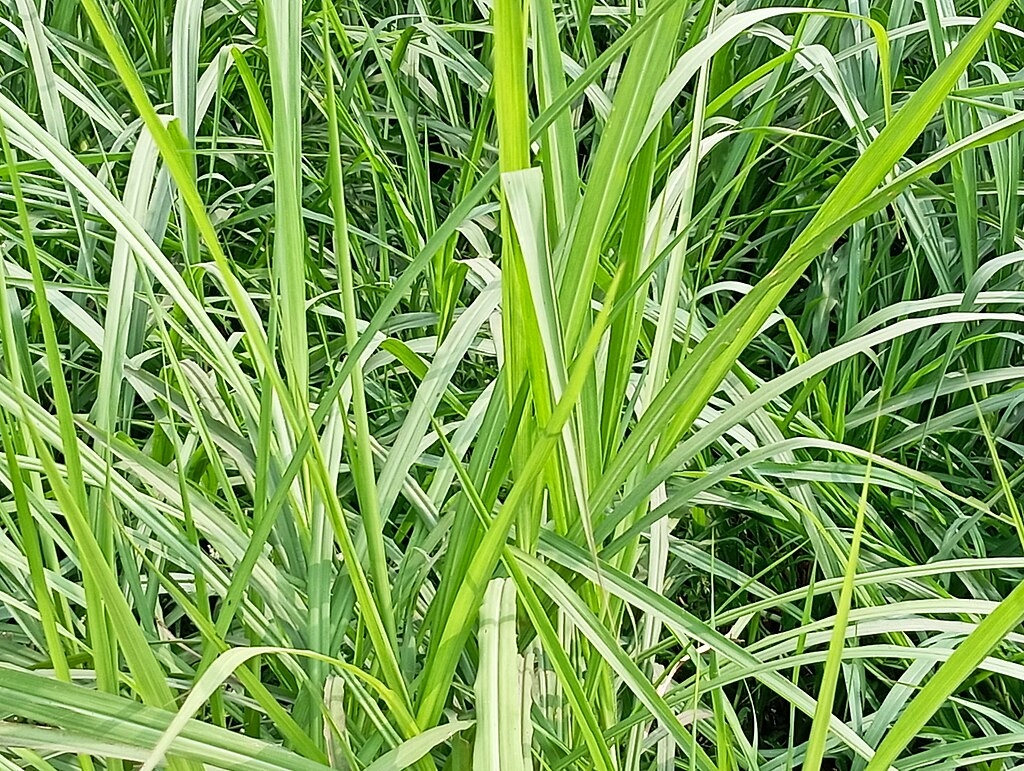Pennisetum purpureum

|
|
Pennisetum purpureum Common Names: Elephant Grass, Napier Grass, Uganda
Grass, Merker Grass Scientific
Classification Kingdom: Plantae Clade: Tracheophytes Clade: Angiosperms Clade: Monocots Order: Poales Family: Poaceae Genus: Pennisetum Species: P. purpureum Authority: Schumach. Synonyms: Cenchrus purpureus (Schumach.) Morrone, Pennisetum benthamii Steud., Pennisetum nigrescens (Hochst. ex A.Rich.) T.Durand & Schinz Morphological Description Pennisetum purpureum is a robust, perennial grass in the Poaceae family, growing
2–7 m tall with a deep, vigorous root system: · Stem: Erect, tufted, 1–3 cm thick, developing from creeping
stolons, glabrous to pubescent near inflorescence (Fern, 2024). · Leaves: Linear, flat, 30–120 cm long, 1–5 cm wide, green, with
scabrid margins and prominent midrib (Barwick, 2004). · Inflorescence: Feathery, cylindrical panicle, 10–30 cm long, yellow-brown
to purplish, with bristly awns (Burkill, 1985). · Roots: Extensive, fibrous, aiding soil stabilization (Heuzé et al.,
2024). Distribution and Habitat Pennisetum purpureum is native to tropical Africa and widely cultivated globally: · Range: Sub-Saharan Africa (e.g., Kenya, Uganda), introduced to
Asia, Latin America, Australia; cultivated in India, Brazil, Taiwan (Fern,
2024). · Habitat: Savannas, grasslands, disturbed areas, 0–2,000 m altitude;
thrives in 25–40°C, 750–2,500 mm rainfall, tolerates sandy to clay soils (Heuzé
et al., 2024). Ethnopharmacology Pennisetum purpureum, commonly known as elephant grass or Napier grass, possesses
several medicinal properties. Studies have demonstrated its antiviral activity,
with extracts inhibiting infections caused by feline coronavirus (FCoV),
porcine epidemic diarrhea virus (PEDV), infectious bronchitis virus (IBV), and
enterovirus 71 (EV71), suggesting potential as a natural disinfectant to limit
viral spread. Traditionally, infusions made from its leaves and stalks have
been used as diuretics, aiding in conditions like anuria or oliguria. In
African folk medicine, the seeds are employed for general healing and to treat
eye and ear afflictions, while the sap is applied to wounds and ear problems.
Additionally, the plant exhibits antioxidant properties, protecting
biomolecules from oxidative damage and modulating antioxidant enzyme activity.
Phytochemical analyses reveal that P. purpureum is rich in flavonoids, phenols,
fatty acids, and amino acids, contributing to its medicinal characteristics.
Furthermore, it has been traditionally used to improve digestion, boost energy
levels, and detoxify the body, with its high fiber content supporting a healthy
balance of gut flora. While these findings support the traditional uses of
Pennisetum purpureum, further scientific research is necessary to fully
validate its medicinal properties and determine appropriate applications in
modern medicine. · Diuretic: Leaf infusions in Nigeria promote urine production; Akuru et
al. (2020) note diuretic effects in rats (200 mg/kg). · Anti-inflammatory/Wound Healing: Leaf paste in Cameroon treats wounds; Jack
et al. (2020) report 40% edema reduction in rats (100 mg/kg extract). · Antivenomous: Root decoctions in Kenya counter snakebites; no direct
studies, but traditional use noted by Burkill (1985). · Measles Treatment: Leaf baths in West Africa for measles;
ethnobotanical surveys confirm use (Tabuti et al., 2003). · Antiviral: Extract (Heyiya®) inhibits coronaviruses (FCoV, PEDV) and
enteroviruses (EV71) in vitro (Chen et al., 2022). ⚠ Toxicity Profile: High nitrate levels (up to 2.5% dry matter) in
young shoots can cause poisoning in cattle; oxalates present but rarely problematic;
hydrocyanic acid reported in some conditions (Heuzé et al., 2024). Additional Uses · Forage: High yield (20–40 t/ha) and protein (8–12%) for livestock in
cut-and-carry systems (Fern, 2024). · Bioenergy: Biomass yield (up to 80 t/ha) for biofuel and biogas
production (Heuzé et al., 2024). · Agroforestry: Erosion control, windbreaks, and push-pull pest management
against stemborers (Khan et al., 2014). References
External Links More Pictures
|
|
| Compounds of Pennisetum purpureum |
|
| References |